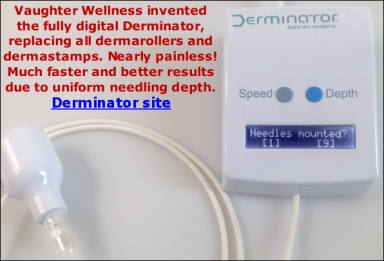Hi Sarah
I have a few questions that I need to clear up in order to help me understand better about derma stamping before I actually begin. I’m an Asian male, 19 years of age and have very pale/ white/ yellow skin colour as my normal skin tone. I want to give a quick description about my skin first. I’m going to be using the stamp on my face for very shallow acne scarring and a bit of hyperpigmentation. The areas that have the minor acne scars are the areas right next to the nose on both sides, which is also, for some reason, the only areas including my nose that gets oily during the day. It doesn’t get very oily where you can see a shine but is oilier then other parts on my face which practically have no oil. These 2 areas are where I had the most acne when I had acne which makes sense since these area’s produces more oil. It also sort of have, I’m not 100% sure, noticeable pores. I’m confused whether these noticeable pores were due to acne and are now shallow scars or are they natural due to genetics and because the skin is oily. I know that oil accumulation can make pores appear ‘larger’ since after a shower, the pores are less noticeable.
Here are the questions I have that I hope may help others who have the same questions too:
1) Would you recommend me exfoliating my skin with my fingers in the showers before I derma stamp? (I do this once- twice a week and I get all this gunk and layer of dead skin afterwards)
2)Should I be stamping dry? As in, do I need to put on any oils/creams to first moisturize the skin before stamping?
3) Do the use of topicals before and after the stamping play a big role in actually inducing collagen? Like say if I only use the stamp, 60% of collagen will be induced but if I use a topical, 80% will be induced. Is this true? Or is the end result all the same whether I use a topical to encourage collagen (Vitamin C) or just stamping and moisturizing?
4) If someone had seen improvements in reducing their pore size, is there a point where the pore will stop getting “smaller”? Or will it keep going until it becomes officially unnoticeable? I’m asking this because I feel as though my pores are already quite smaller, and even after I stamp, they won’t “shrink” any further.
5) Since I have tiny isolated noticeable pores, if I penetrate a pore, like if the needle goes directly into a pore, will it stretch it? This is just a visual fear that I had thought about and I know that there are many needles surrounding each needle and that this would make more sense if it was a single needle. This is the only possibility that I see that a pore can get “bigger”/ worse. If there are other factors that a pore can get larger, please let me know.
6) Is there any possibility that my derma stamp can give me hyperpigmentation? What is the difference between a white head giving me hyperpigmentation then a derma stamp?
7) Is it OK to moisturize right after I derma stamp? Can I use oils such as coconut oil, olive oil, or almond oil? Which one would be better with the less chance of encouraging any breakouts as I have never used oils but I want to for my derma stamping.
8 ) My skin has decreased a lot in terms of being red since my acne days (acne subsided about a year ago) but it still is a little bit pink. Once I derma stamp, I know that my skin will get really red and somewhat swollen but since right now it is still a little bit pink, will making it more red with stamping encourage my skin to remain somewhat pink for ever?
Those are the questions I have, hope it isn’t too much!
Once I begin derma stamping I plan on eating more vegetables, fruits, and protein, not that I don’t now. I also am planning to get a lot of sleep every night and stay indoors for about a week. All in all, my biggest fear would be if the pores get bigger and “stretch out” more rather then becoming smaller. I have purchased the 0.5mm derma stamp as I heard it is the shortest needle length that can induce collagen and also since I have shallow and isolated and minor scarring with a few hyperpigmention. I think it’s best to start out small to see how my skin reacts first.





